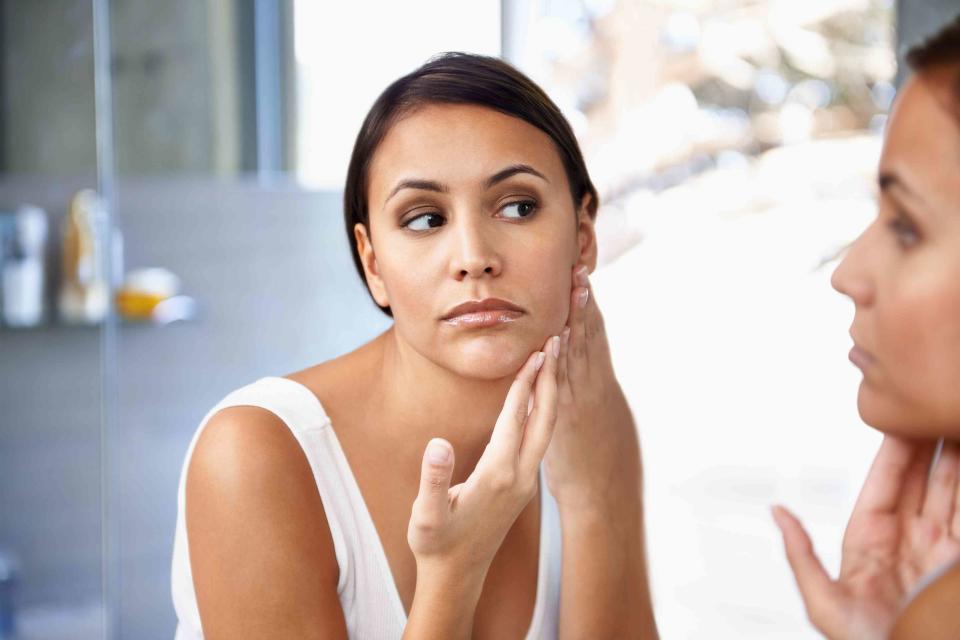Here’s What’s Causing Your Jawline Acne, According to Pros
Experts share common culprits for jawline acne and solutions for each.

PeopleImages / Getty Images
All pimples are frustrating to deal with, but some argue that jawline acne is in a league of its own. This type of acne can show up as a thick smattering of irritated red zits across your chin and jaw, or it can present as large red bumps that are often painful to the touch. One thing about jawline acne, though, is that you can often narrow down the specific culprit pretty quickly.
With expert insights from skincare pros, we’ve outlined the most common causes of jawline acne so you can get back to clearer skin.
RELATED: Acne Face Mapping—Learn What Causes Breakouts on Each Part of the Face
1. Hormonal Fluctuations
Looks Like: Deep-set, tender cysts along the jawline and chin that can last a while
Hormonal acne often presents along the jawline. It’s caused by an uptick in oil production, which manifests as cystic acne when merged with dead skin cells and bacteria.
“This is frequently observed in women during their menstrual cycle, while pregnant, or when afflicted with conditions such as polycystic ovary syndrome (PCOS),” says board-certified dermatologist Danilo C Del Campo, MD, FAAD. “However, even changes in stress levels can produce these changes.”
How to Treat It
Tackling hormonal acne may require a strategic combination of treatments. Dr. Del Campo says that retinoids can help prevent pores from clogging. Also, women can try treatments that regulate hormones, such as certain birth control pills or spironolactone. “A personalized treatment approach from a board-certified dermatologist is essential, and they can also help manage any underlying hormonal issues,” Dr. Del Campo says.
2. Chafing/Friction
Looks Like: A smattering of inflamed and non-inflamed blemishes, such as pustules and blackheads, in the area where friction is created
Consistent friction and rubbing can cause acne to occur along the jawline. This is why “maskne” occurs, and you can also deal with breakouts in this area from wearing chin straps or helmets, having a beard, rubbing your phone against your face, and from anything else that rubs in this area. This is referred to as acne mechanica, and the friction compromises your skin’s natural barrier.
How to Treat It
First, try to minimize the source of this physical irritation. Second, make sure to clean anything that comes into contact with your skin, advises Merry Thornton, PA-C, founder of Element Medical Aesthetics in New Canaan, Conn. She adds, “You can use a product containing salicylic acid to dissolve sebum from the pores.”
3. Your Diet
Looks Like: Cystic-like acne lesions that are deep in the skin and may not surface
Certain lifestyle factors, including diet, can potentially trigger acne.
“Studies suggest that diets composed of foods with a high glycemic index, such as white bread, white rice, and sugary drinks, cause a rapid spike in blood sugar,” notes Brendan Camp, MD, FAAD, a board-certified dermatologist at MDCS Dermatology. “This spike in blood sugar can initiate a hormonal cascade that stimulates sebum production and triggers acne formation.”
How to Treat It
Dr. Camp recommends modifying your diet to exclude or decrease high glycemic index foods. You can also increase your intake of low glycemic index foods, like broccoli, apples, peanuts, and chickpeas. “This can potentially reduce the risk of developing new acne,” he says.
4. Makeup & Skincare Products
Looks Like: Small blemishes, including blackheads, whiteheads, or tiny reddish spots
“Certain cosmetic and skincare items have ingredients that can block pores, leading to acne,” says Dr. Del Campo. “The jawline is especially susceptible, as it's an area where these products might gather or be applied more densely.”
How to Treat It
The best way to treat this type of jawline acne is to make adjustments to the products you use. This can be tricky, but eliminating the culprit(s) will help tremendously. Dr. Del Campo recommends using products labeled as “non-comedogenic” or oil-free. You can also test products before fully applying them.
5. Poor Cleansing Technique
Looks Like: Clogged pores and large pimples at the jawline or just under it
Similarly, leaving skincare products on your skin overnight can lead to clogged pores and breakouts. When we wash our face, we tend to focus on the cheeks, nose, and forehead, but end up not cleaning our jawlines and necks as well.
How to Treat It
Increase your face wash time to one or two minutes and make sure to cleanse your jawline and neck. Also ensure you’re rinsing your cleanser well from this area. Double washing and/or gently rubbing a cotton pad soaked in micellar water along this area can endure a great clean. If you see any product residue on the pad or your washcloth when drying, this is a sign you’re not cleaning well enough.
6. Progesterone Birth Control
Looks Like: Inflammatory acne tends to be more deep-seated and tender.
Dr. Camp notes that progesterone birth control, like an IUD, can cause jawline acne-and acne on the lower portion of your face in general—due to the surge of hormones.
How to Treat It
“Discuss concerns about acne prior to starting a new form of contraception with your provider,” Dr. Camp says. “You can also consult a board-certified dermatologist to develop a treatment plan if acne flares after starting a new form of contraception.”
For more Real Simple news, make sure to sign up for our newsletter!
Read the original article on Real Simple.

